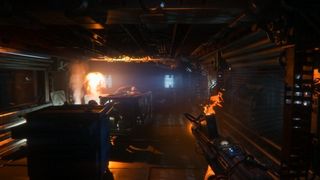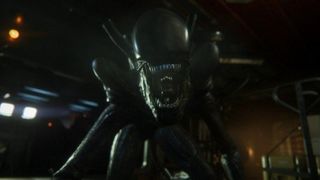
By Richard Wordsworth.
Something had gone terribly wrong. Maybe it was in my brain; perhaps something had been throbbing, pulsing, and then suddenly popped—like in those CGI, inside-the-body shots in an episode of House. I'd been wandering around a space station, on the run from a horrible monster, jumping at shadows and yelping when something leapt out of the shadows and skewered me on the end of its tail. Now I was laughing. Laughing! At Alien: Isolation! Stop the ride. Something's come off.
Nothing had gone wrong, really. If anything, something had gone right. I wasn't laughing at the monster. No, this was the Oculus Rift's fault. I'd like to say it was something worthy, like the surreal sensation of looking about at an environment I knew wasn't real, or at apparently sprinting while sitting still in a chair. It wasn't, though. It was looking down to discover I had boobs. It was inexpressibly weird. I was in someone else's body. Someone with slimmer arms than me and whole pieces of anatomy that I'd only ever seen on other people. The fact that beyond my newfound chest adornments I didn't seem to have any legs somehow just made it better. All the tension that had built up hiding and fleeing and cowering in terror twisted up and burst out of me. I couldn't stop.
Suddenly the Amanda Ripley I was inhabiting forgot all about her life-and-death struggle against the loping, impossible force of anti-nature that had her cornered on a derelict space station, and raced off to explore her virtual surroundings, like a kid spoiling a museum trip. I ran over to one side of the room and looked at a wall. It was a great wall! I went through a door and felt just for a moment that I was going to bash my head against the frame. I ducked reflexively in my chair, and because the tech demo was running on the latest iteration of the Rift, the camera tracked my real-world head movement and Amanda stooped down, too. Unnecessary, but highly obliging.

I hid in a cupboard. The Sevastapol space station is full of cupboards in which no-one seems to store anything. Presciently, as it turns out, as jumping into a locker and holding your breath (left trigger) is sometimes an effective way of avoiding a pursuing monster. I peered out through the slats in the front of the metal door. All was quiet. I tilted my head, looking up at the ceiling, then down at the floor. I was beside myself. Surely no-one has ever been this excited to be hiding in a cupboard who isn't now on some kind of register.
After a minute or so, a door opened in the starting room. The stage I was playing was a tech demo for the Oculus stand at E3—a prototype in which you have to skulk from one end of a closed-off level to the other without being detected. You've got no weapons, no distracting gadgetry, and three minutes to escape after that door opens and lets you into the level proper. Basically, this demo was designed to kill people queuing at the Oculus stand quickly, so they'd get off and let someone else have a go.
I felt none of that urgency. I blundered into the corridor and pulled up my Motion Tracker again. Nothing on the screen. Enemies in Isolation show up as they do in the films: as little white blobs announced with a cold, audible ping. I saw no blob. Heard no ping. Whatever was waiting for me in the demo, it hadn't arrived yet.
The biggest gaming news, reviews and hardware deals
Keep up to date with the most important stories and the best deals, as picked by the PC Gamer team.
That's when I saw the box. Never have I been so happy to see a box. There wasn't even anything in it, I knew—but I could see from the grill on the front that it was something else that I could clamber into. The entry animation played out in first-person whilst I remained sedentary outside of the Matrix in an office chair. I got in. I looked out through the eye-slits. Then I saw some legs.

I knew it was The Bastard. The developers call it the Alien, but really, it's The Bastard. It's quicker than you, can't be killed, learns from your behaviour and once made me swear—loudly and in front of people—when it pulled me out from cowering under a hospital gurney. How long had it been there? Had it followed me? It can drag you kicking out of cupboards and boxes, too, if it sees you disappear into one—but for the moment, it was pulling one of its nastier tricks: standing stock still, like it knows not moving will keep it off your Tracker. Move and stop. Move and stop. Eat someone that blunders into you when they think the coast is clear. Alien Hunting 101.
Despite the developer's assurance that basically no-one made it through the gauntlet alive, I didn't want to chance being the one survivalist prodigy who made it to the end screen without seeing what it was like to be stabbed in the face with the Alien's signature telescoping mouth-tongue. So, after a few tense seconds of waiting for discovery, I took matters into my own hands. I burst out of my box and charged head-first at the monster. Probably scared it half to death. But then it grabbed me, threw me to the floor, got on top of me, opened its mouth and dribbled on me with its clicking mouth proboscis. Then it punched a hole in my face.
It was another weird feeling. In the main, non-VR game, getting caught by the Alien is terrifying. You never mean for it to happen; it's always because you've been careless and gotten yourself noticed by a monster you hadn't seen. This was different. This was gleeful.

I restarted the demo. Time to play seriously. This time the Alien showed up sooner, stalking down a corridor at me. I ducked down a different one, thinking I might circle around it. No such luck. Watching the motion tracker I simultaneously was and wasn't holding in my left hand, I watched glumly as it doubled back and once again started coming at me. I got down behind some crates and leaned right in my chair, the Rift camera tracking my head as I poked half an eye out to investigate.
I was about eye-level with its knee. Somehow, the Bastard had skulked forward while I was scanning for it and I'd missed its approach. Now the ping on the radar was frantic. But as I ducked my precious, vulnerable head back in like a tortoise made of shipping crates, somehow it didn't see me. Ha! "Perfect organism," indeed!
Emboldened, I decided to slip around behind it and back away towards the objective marker on my Tracker. The Bastard was scoping out another room from the doorway, and I didn't have far to go before the relative safety of the next corridor. Then, out of line-of-sight, I could scuttle off to the exit and enjoy the duel honours of having been at once eviscerated in VR by an iconic monster of my childhood, and one of the few people in the world skilled enough to actually finish this demo. Glory and bragging rights were within my virtual grasp. All I needed to do was creep across maybe twenty feet of open corridor, and cross all the toes that Virtual Ripley didn't have that the Alien wouldn't turn round.

It did. Immediately. In fact, I was so close when it spotted me that a quicker-thinking Ripley could have boffed it on the snout and maybe made good her escape. I didn't do that. I did what everyone does—what the game explicitly tells you not to do—and turned on my heel and ran away, yelling. Then I fell over. Something had grabbed my non-existent legs out from under me and was dragging me backwards across the floor. Death came swiftly on another set of dribbly teeth. I died a victim of hubris as much as the gangly monster I'd tried to outfox.
I didn't finish the demo for Alien: Isolation's VR mode (which, incidentally, hasn't been confirmed as something that's happening yet—after I emerged, blinking, in Sega's offices, the developer stressed that the demo is strictly a proof of concept). I don't think I even came close. But oddly, I don't really care. I don't know how long I could play the murkier, heart-in-mouth segments Isolation's full story with my brain trapped mercilessly in virtual reality—but the sheer, untainted joy this demo inspired with nothing more than some cupboards and a box would make me want to try.
PC Gamer is the global authority on PC games—starting in 1993 with the magazine, and then in 2010 with this website you're currently reading. We have writers across the US, Canada, UK and Australia, who you can read about here.
Most Popular

